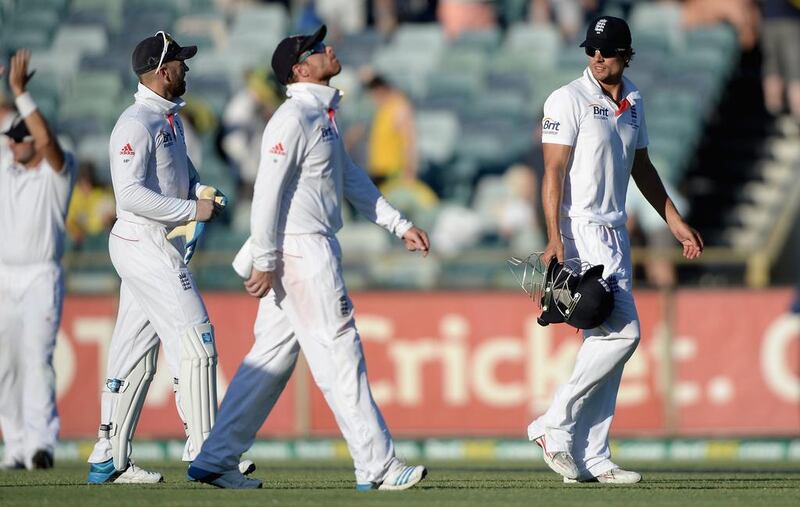It is a sad fact of life that reality seldom matches the anticipation that precedes it. That is especially true of sport, where contests hyped to ridiculous levels often go the way of the bout between Mike Tyson and Michael Spinks. That one lasted all of 91 seconds.
Two-and-a-half years ago, an Indian cricket team arrived in England for a four-match series, the first Test of which would also be the 2,000th played. India had won the World Cup on home soil three months earlier, and had spent more than 18 months as the No 1-ranked team in Test cricket. Ranged against them were an England side that had gone to Australia the previous winter and won three Ashes Tests by an innings.
India lost Zaheer Khan, their bowling star, on the opening day of the series at Lord’s. They made 286 and 261 there, and followed up with 288 and 158 at Trent Bridge, a Test that they controlled for the best part of two days. When they managed just 224 in the first innings at Edgbaston and England replied with 710 for seven declared, it was quite clear that the No 1 ranking would not be theirs for much longer.
That India team was excoriated in the British media, and not without reason. Several players turned up in less-than-prime fitness and it was reflected in performances – with a couple of notable exceptions – that were devoid of the intensity one expects from a team with pretensions to be the best.
Compare that to the ongoing Ashes series. After winning 3-0 in the home series, England were considered strong favourites to go down under and retain the urn. Instead, they have managed 136, 179, 172, 312 and 251 in their five innings so far. Australia are likely to set them a target far in excess of 400 in Perth, where they have made it to 350 just once in six consecutive defeats dating to 1990/91.
Unlike that 2011 Indian side, which had risen up the rankings largely because of a formidable batting order, much was expected from this England bowling attack.
Yet, in the same Tests where their batting has collapsed like a badly made souffle, the bowlers have conceded 401, 570 and 385. But for Stuart Broad, whose 14 wickets have come at 25 apiece, no bowler averages less than 40 with the ball. James Anderson and Graeme Swann have just seven wickets apiece, and have needed more than 100 deliveries to get each one. It is the stuff that Ashes nightmares are made of.
But if the bowling and butterfingered catching has been a disappointment, the batting has been ghastly. India’s disintegration in 2011 was near total, but there was still Rahul Dravid to strike a note of defiance. In the first five innings of that series, he managed 284 runs with two centuries. England’s best performers with the bat so far are Michael Carberry (157 runs) and Alastair Cook (154).
Where Australia’s batsmen have reeled off six hundreds, the highest score for England so far is Joe Root’s 87 in Adelaide. That he has managed just 47 runs in four other innings should tell you just how inconsistent the line-up has been.
The tipping point for India’s English misadventure was the loss of Zaheer, the only world-class pace bowler in their ranks. The emblematic image of England’s Ashes travails has been the sight of Jonathan Trott walking off the Gabba in Brisbane after being suckered into the hook in the second innings.
It would be the last we would see of him, as he left the tour with stress-related problems.
It is hard to put a finger on what happens to teams and players when their fortunes go into a downwards spiral. It is not pretty to watch, though. India in 2011 looked like an ageing prizefighter that had taken one punch too many. They bumbled from one setback to the next and were figures of derisory fun by the end of it all, especially when a pear-shaped RP Singh – fresh off a holiday on Miami’s beaches – was called up to open the bowling at The Oval.
Tim Bresnan best illustrates England’s decline. In his first 10 Tests, all of which England won, Bresnan took 41 wickets at 23.60. In his next 12 Tests, during which time he had elbow surgery and the average swelled to 33, he has just 28 wickets. Compared to the heat sent down by Australia’s pace trio in Perth, Bresnan has offered the threat of a peashooter.
A couple of the India players who were in England in 2011 have conceded in private, with the benefit of distance and perspective, that a dip in desire and intensity had much to do with the 4-0 drubbing. Having reached the top of the Test mountain and won the World Cup, there were a few players who found themselves asking: “What now?”
England, despite the losses to Pakistan and South Africa in 2012, have enjoyed their best half-decade as a Test side since the 1950s. The likes of Cook, Anderson, Swann and Kevin Pietersen – cornerstones of three consecutive Ashes successes – are already guaranteed places in the England cricket pantheon.
Reputations do not win cricket matches, though, and England are finding, as India did in 2011, that the fall involves less time and far more pain than the ascent.
sports@thenational.ae





